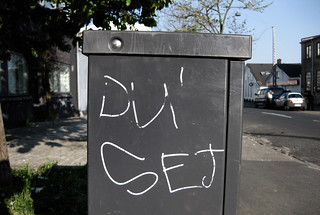4 Easy Ways To Be Posted by Bjørn A. Bojesen on Mar 8, 2013 in Grammar
It’s been a while since I last talked to you about grammatik ([gramaTICK], grammar). For some learners, that’s more or less a necessary evil. I always say that learning grammar can be just as sjovt ([shorwt], fun) as exploring the culture or learning vocabulary. Let’s talk about at være (to be).
One of the first Danish words you’ll encounter, is the present tense er (am, are, is). It’s pronounced somewhere between British English air and are (but closer to air):
Jeg er bare så glad! (I’m just so happy!)
Hvem er du? (Who’re you?)
Min familie er på rejse i udlandet. (My family is on holiday/travelling abroad.)
De er i Grækenland. (They’re in Greece.)
- Let, ikke? (Easy, huh?) In order to make questions, you just move er up front:
Er du hende fra Canada? (Are you ”her” [= that girl] from Canada?)
Er I klar? (Are you ready?)
Er han stadig hjemme? (Is he still at home?)
Negative phrases are made by inserting the little word ikke right behind er:
Nej, jeg er ikke hende fra Canada. (No, I’m not that girl from Canada.)
Nej, han er ikke hjemme i dag. (No, he’s not at home today)
When making questions, the word ikke stays at its place!
Er han ikke hjemme i sin lejlighed? (Isn’t he at home in his apartment?)
Stuck in the past
The past tense works in the same way. You just replace er by var (was, were)!
Hvor var du i går? (Where were you yesterday?)
Hun var ikke kunstmaler i 1997. (She wasn’t a painter/artist in 1997.)
Has been, had been…
When you want to tell people where or what you have been, the words to use are har været [har VARE-th]. In the past, that’s havde vært ([ha-th VARE-th], had been). It all works pretty much as in English:
Amalie har været alene på Nordpolen. (Amalie has been alone on the North Pole.)
De havde aldrig været i Skagen. (They had never been to Skagen.)
Vær forsigtig!
Be careful!
- There’s no direct way to say I am waiting… or Are you coming? in Danish. Instead, you just say Jeg venter… (I wait) and Kommer du? (Come you?)
- Very often when telling where something is (located), Danes will use the words ligger (lie[s]), sidder (sit[s]) or står (stand[s])
Fredericia ligger i Jylland. (Fredericia is in Jutland.)
Jeg sidder i stuen! (I’m in the living room!)
Vinen står i skabet. (The wine is in the cupboard.)
3. In casual speech, er is often dropped entirely. To show this tendency in writing, an apostrophe is used. So, if you get an SMS with the text Du’ sød, and I tell you sød means ”sweet”, you should know what they mean! 🙂

Build vocabulary, practice pronunciation, and more with Transparent Language Online. Available anytime, anywhere, on any device.
About the Author: Bjørn A. Bojesen
I was born in Denmark, but spent large parts of my childhood and study years in Norway. I later returned to Denmark, where I finished my MA in Scandinavian Studies. Having relatives in Sweden as well, I feel very Scandinavian! I enjoy reading and travelling, and sharing stories with you! You’re always welcome to share your thoughts with me and the other readers.





